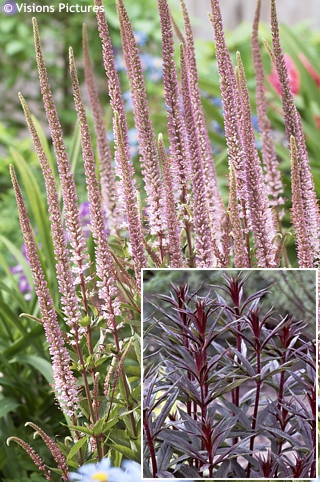Veronicastrum virginicum 'ERICA'

Veronicastrum virginicum 'ERICA'
culver's root
culver's root
| SIZE/TYPE | mid-sized perennial |
|---|---|
| tall perennial | |
| USUAL HEIGHT | 0.8-1m |
| USUAL WIDTH | 0.5-1m |
| LEAVES | deciduous broadleaf |
| COLOUR OF LEAVES |
 + + multicoloured:burgundy red and green multicoloured:burgundy red and green |
| FLOWERS | showy |
| COLOUR OF FLOWERS |
 lilac lilac
|
| BLOOMING TIME | July - August |
| LOCATION | full sun |
| USDA zone (lowest) | 3 (down to -40°C) |
| WINTER PROTECTION | |
| FOR ZONE 5+6 |

|
| FOR ZONE 7 |

|
| BELONGS TO CATEGORIES |
Perennials Summer blooms |
If looking for a perennial with interesting architecture that would look great or even dominant among shrubs or trees, perhaps could be a substitute for a shrub in places where there is not enough space, culver’s rootmight be the one for you. This genus has two species, each of them is named after its origin: Virginian and Siberian. They are very similar and differ mostly in flower colour and size in maturity. Formerly named as veronica (speedwell) it was decided that culver’s root is so unique that it deserves its genus.
Virginian culver’s root produces several whorls of chaste-tree-like, narrowly lance-shaped, mid to dark green leaves. They may resemble cannabis. In early summer the tips of the stems begin producing flower buds composed in long spikes, botanically more correctly classified as terminal racemes, opening in into small flowers in early July.
Erika is a big looker among culver’s root varieties. In spring it emerges with deep burgundy purple leaves which turn green in summer, and from early spring are formed exceptionally long spikes composed of rosy red buds which open to pale pink flowers from July until August. The plant is much denser and compact compared to the species and its stems seldom exceed 1m tall. Individual flowers are tubular and decorated with long white stamens with sandy yellow anthers owing to which they look hairy.
Culver’s root will grow in evenly moist, fertile soil in full sun or with some shade during the day. It requires no maintenance whatsoever except for removing dead stems in early spring and some extra watering in very dry summers. It is hardy to about -40°C (USDA zone 3).
Last update 09-11-2020
Virginian culver’s root produces several whorls of chaste-tree-like, narrowly lance-shaped, mid to dark green leaves. They may resemble cannabis. In early summer the tips of the stems begin producing flower buds composed in long spikes, botanically more correctly classified as terminal racemes, opening in into small flowers in early July.
Erika is a big looker among culver’s root varieties. In spring it emerges with deep burgundy purple leaves which turn green in summer, and from early spring are formed exceptionally long spikes composed of rosy red buds which open to pale pink flowers from July until August. The plant is much denser and compact compared to the species and its stems seldom exceed 1m tall. Individual flowers are tubular and decorated with long white stamens with sandy yellow anthers owing to which they look hairy.
Culver’s root will grow in evenly moist, fertile soil in full sun or with some shade during the day. It requires no maintenance whatsoever except for removing dead stems in early spring and some extra watering in very dry summers. It is hardy to about -40°C (USDA zone 3).
Last update 09-11-2020
SIZES and PRICES
CURRENTLY SOLD OUT
GLOSSARY
|









